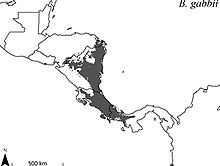| Northern olingo | |
|---|---|

| |
| in Costa Rica | |
| Scientific classification | |
| Domain: | Eukaryota |
| Kingdom: | Animalia |
| Phylum: | Chordata |
| Class: | Mammalia |
| Order: | Carnivora |
| Family: | Procyonidae |
| Genus: | Bassaricyon |
| Species: | B. gabbii
|
| Binomial name | |
| Bassaricyon gabbii Allen, 1876
| |

| |
| Northern olingo range[2] | |
| Synonyms | |
|
Bassaricyon richardsoni J. A. Allen, 1908 | |
The northern olingo (Bassaricyon gabbii), also known as the bushy-tailed olingo or, simply, the olingo (due to it being the most common of the species),[2] is an arboreal (tree-dwelling) member of the raccoon family, Procyonidae, which also includes the coatimundis and kinkajou. Native to Central America, it was the first species of olingo to be scientifically described; while it is considered by some authors to be the only “true” olingo species,[3] a review of the genus Bassaricyon had shown there to be a total of four species, two of those now being considered synonymous with the northern olingo.[2] Its specific name honors William More Gabb (1839-1878), who found and collected the first specimen for western science.[4][5]
- ^ Helgen, K.; Kays, R.; Pinto, C.; González-Maya, J.F.; Schipper, J. (2016). "Bassaricyon gabbii". IUCN Red List of Threatened Species. 2016: e.T48637946A45196211. doi:10.2305/IUCN.UK.2016-1.RLTS.T48637946A45196211.en. Retrieved 19 November 2021.
- ^ a b c Helgen, K. M.; Pinto, M.; Kays, R.; Helgen, L.; Tsuchiya, M.; Quinn, A.; Wilson, D.; Maldonado, J. (15 August 2013). "Taxonomic revision of the olingos (Bassaricyon), with description of a new species, the Olinguito". ZooKeys (324): 1–83. doi:10.3897/zookeys.324.5827. PMC 3760134. PMID 24003317.
- ^ Cite error: The named reference
msw3was invoked but never defined (see the help page). - ^ Cite error: The named reference
Prange2009was invoked but never defined (see the help page). - ^ Beolens, B.; Watkins, M.; Grayson, M. (2009-09-28). The Eponym Dictionary of Mammals. The Johns Hopkins University Press. p. 145. ISBN 978-0801893049. OCLC 270129903.
